Abstract
The increasing social demands for scientific collections in botanical gardens, their display and practical use are the driving force for the development of both the collections themselves and various forms of their study. However, on the one hand now there is quite little research in the field of the functions of both the botanical gardens themselves and their collections. On the other hand, the educational function, as an integral feature of modern leisure in botanical gardens, uses the accumulated biological and ecological knowledge to transmit it to a wide audience. The paper presents the analysis of the significance of indoor and outdoor plant exposure for visitors to the Peter the Great Botanical Garden (St. Petersburg, Russia). The authors conclude about the importance of the public's request to the collections in order to increase their educational function. As examples, the overview of the greenhouse collection of plants, temporary exhibitions, outdoor collections and floral decoration is given. The analysis of individual collections of the Peter the Great Botanical Garden demonstrates their functional purpose, educational potential and current areas of exposure for further development. The authors describe the mutual influence of the educational function and the development of collections now. The paper presents the developed directions for the development of botanical collections and the conditions under which the educational function can be implemented.
Keywords: Botanical garden, collections, education, educational function, plants, visitors
Introduction
It is known that plants have played a significant role for humanity since ancient times: they were eaten and used for domestic and medicinal purposes. The development of these functions can be traced in the course of history. In the ancient Egyptian, as well as in the philosophical and privately owned gardens of ancient Greece, religious, utilitarian and aesthetic functions were organically combined. They were replaced by the pragmatic functions (food and medicine) of the monastic order gardens of the Middle Ages (Zhirnov, 1977). In the 14th century practical medical gardens began to play an important role. The transition to an aesthetic function was observed from the 15th to the 17th century in the organization of regular French gardens and in examples of British garden art. During the period of great geographical discoveries, the role of the scientific function of gardening increased: scientists published works in an attempt to catalog the increasing number of plants. Then, in the 19th and 20th centuries, the trend was towards a combination of specialized and eclectic collections, showcasing many aspects of both horticulture and botany (Balasubramanian, 2021). Garden experts state that over the years the role of botanical gardens as cultural and scientific organizations in society is growing, and the Gardens are increasingly trying to take into account the needs of their visitors. It has also been noted that modern gardens must combine their social and ecological functions (Dodd & Jones, 2010).
Nowadays, most botanical gardens have a mixed function, as plants continue to play an important role in human life and society. The urbanization of cities has led to the formation of new strategies for the development of diverse plant display functions. In this regard, the botanical garden in the city seems to us to be a unique object, where the role of all the above-mentioned functions is taken into account during the organization of the exhibition of plants, but now the educational function is becoming more important. In Russia, the educational function of the Gardens did not begin at the end of the 19th century and started to develop only in the 40s of the 20th century. For example, in 1935 in the Botanical Garden of St. Petersburg (at that time Leningrad) a cultural and educational sector was organized in which 15 worked and 20 guides worked in 1939 and 1940. It is known that in the 40s of the 20th century up to 150 thousand tourists per year passed through the greenhouses and in addition to the greenhouses, excursions were also conducted in the park (Sokolov, 1957).
Education as a necessary basis for the development of botanical collections is focused on the search for new approaches and methods of presenting collections of living plants. As Missouri Botanical Garden President Peter Wyse Jackson points out, innovative approaches to plant conservation and public awareness are needed to achieve the conservation goals of the Global Strategy for Plant Conservation (Peter Wyse Jackson, 2013). The collections of living plants created in the Botanical Gardens are the basis for a comprehensive analysis of the success of the introduction of different groups of plants. It can also serve as a basis for various scientific and educational programs (Tkachenko, 2014). Thus, for example, specialized ethnobotanical compositions of medicinal plants in the botanical gardens of China are designed to acquaint visitors with plants used in traditional medicine of different peoples of China (Tkachenko & SHi, 2018; Tkachenko, 2019).
In turn, botanical collections, dynamically developing, influence the level of education of visitors, spreading certain knowledge, posing problems and ways to solve them. Arnautova and Yaroslavtseva (2018), considering the thematic greenhouse collections of the Botanical Garden of Peter the Great, speak of their great importance for thematic excursions. Data are also provided on the educational and applied significance of individual botanical collections, for example, representatives of the Commelinaceae family (Yaroslavtseva, 2017) and representatives of the genus Syringa (Kalugin, 2018). At the same time, the surveys of visitors to the open ground of the Peter the Great Botanical Garden in different years show that the majority of respondents put education in the Garden in the first place and choose the Garden as a place for education and recreation (Kalugin et al., 2019).
Unlike formal education, botanical garden specialists do not have the task of fixing the level of knowledge of visitors. Here we are talking about the help to further advance scientific knowledge, broadening our horizons and promoting the latest technologies, such as growing plants.
There is not much research on the functions of botanical collections. The study of Korean specialists who studied the difference in the perception of the functions of the Garden and the park in different groups in descending order of importance is of great interest. Conclusions are given about the degree of importance of cultural, environmental and social functions for visitors to the Gardens and parks. Interestingly, the authors obtained data for the middle class (group A), which recognized aesthetic beauty, health, environmental protection and water circulation as important functions of the garden. An important conclusion of scientists is not only a summary of the mixed function of gardens and parks, but their gradual differentiation (Mi-Ok et al., 2020).
Russian specialists assessed the motives of potential visitors to botanical gardens and found that a large number of respondents when visiting botanical gardens pursued educational goals. An interesting fact is that visitors aged 55 years and older prefer mainly educational programs aimed to get knowledge and skills in the natural sciences (Ischenko et al., 2020). Participants of the Night of Museums in the Botanical Garden of Peter the Great, on the contrary, show that their motives for visiting the Botanical Garden were "relaxation" – 42.41 % of respondents, and "the opportunity to gain knowledge" – only 25.13 % of respondents (Kalugin & Musinova, 2020).
Thus, at present, there is a synthesis of pragmatic, educational, aesthetic and scientific functions of botanical collections. The set of functions in the historical context can be represented as the basis for the activities of modern Gardens (Figure 01). However, it is probably the botanical collections that have every reason to increase the role of education in the Gardens, and therefore, increase the importance of the educational function due to the interest of society, activities in an urban environment, the presence of scientific and horticultural professional staff, the concentration of scientific achievements in crop production and diversity collections.
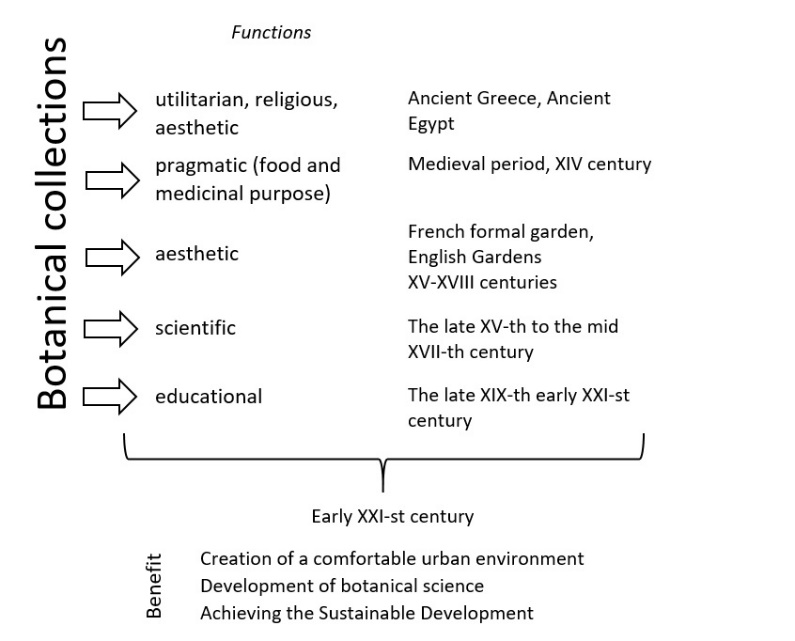
Problem Statement
Increasing social demands for scientific collections, their exposure and practical use are the driving force for the development of both the collections themselves and various forms of their study. However, nowadays there is quite little research in the field of the functions of both the botanical gardens themselves and their collections.
On the other hand, the educational function, as an integral feature of modern leisure in botanical gardens, uses the accumulated biological and ecological knowledge to transfer them to a wide audience. Modern methods and techniques of education in botanical gardens should be put into practice when exhibiting thematic collections in order to make visitors widely aware of the latest selection, features of plant biology and ecology, the importance of biodiversity conservation, etc.
Research Questions
The subject of research are as follows:
- Enlightenment on the basis of the botanical collections of the Botanical Garden of Peter the Great.
- Educational potential of the collections of the Botanical Garden of Peter the Great.
Purpose of the Study
The purpose of the study is to analyze the educational function of the botanical collections of the Botanical Garden of Peter the Great as the basis for their development.
Research Methods
The educational potential of individual collections of the Botanical Garden was analyzed. The effectiveness of the influence of the information component (labeling, stands, etc.) on the perception of the Garden by visitors was evaluated. The interaction of visitors with objects of flower decoration was studied, the method of questioning and pedagogical observation was used.
Findings
In the Botanical Garden of Peter the Great, both permanent and temporary greenhouse plant expositions, comprising more than 13,500 taxa, have educational purposes. Permanent greenhouse expositions include: "Conifers and ferns of the subtropical regions of the globe", "Plants of the Mediterranean and South Africa", "Plants of Australia and New Zealand", "Subtropical plants of Southeast Asia", "Higher spore and gymnosperms", "Plants of the arid regions of the Earth", "Plants of savannas and monsoon forests", "Plants of the humid tropical forest", "Ornamental and useful plants of the tropics", "Fruit plants of the tropics", "Ornamental herbaceous plants of the tropics". Through the example of permanent exhibitions, visitors have the opportunity to study the following topics:(History of the creation of the oldest Botanical Garden in Russia; Botanical Garden during the Second World War);(continents and parts of the world; deserts and semi-deserts of the Earth; economic geography; geographical discoveries);(life forms; habitat of living organisms; ethnobotany; methods of studying nature; convergent evolution; biocenoses);(environmental factors and their impact on living organisms; natural ecosystems);(medicinal plants; poisonous plants). Among the permanent expositions, we should highlight the collection of cacti and other succulent and xerophytic plants – the oldest and largest in Russia and one of the oldest in the world. Currently, it has about 2500 taxa (39 families, including 291 genera), of which 1246 species and varieties are cacti. The most interesting species are presented in the exposition greenhouse "Plants of arid regions of the Earth" (Arnautova & Romanova, 2016). As a rule, when planning and organizing indoor collections in most botanical gardens, the geographical principle is taken into account, which is demonstrated when describing the permanent exhibitions of the Botanical Garden of Peter the Great. However, during the organization of temporary exhibitions, the possibilities increase.
A feature of temporary exhibitions is the concentration of thematic exhibits and visual material, and the methods of its presentation make it possible to acquaint adults and children with biological and environmental knowledge in the most complete and versatile way. In the last 10 years, thematic exhibitions have been organized annually: tulips, lilacs, begonias, auricles, succulents, gladioli and dahlias, peonies, phloxes, orchids, hostas, etc. (Figure 02). One of the main objectives of temporary exhibitions is to popularize botany and educational activities in the field of natural sciences with an in-depth presentation of specialized material designed for visitors of different ages and backgrounds.
The analysis of the development of the educational function at temporary expositions can be traced back to the time of the social request for exhibitions in 2005–2006, where aesthetics and the acquisition of basic knowledge about gardening were decisive (exhibitions of peonies, phloxes, dahlias, etc.). The second stage in the development of exhibiting was the development of this subject with the provision of scientific data on the achievements of selection and the dynamics of exhibiting "from species to variety" (begonias, succulents, maples, etc.). The third stage of the exhibition was the organization of exhibitions based on the ecological principle for scientific and educational purposes, with an emphasis on general ecological knowledge (epiphytes, succulents). At the fourth stage, on the basis of the previous blocks, topics were developed for various social groups and exhibitions were created in order to expand naturalistic erudition (plant metamorphoses, textile plants, invasive plants, etc.).
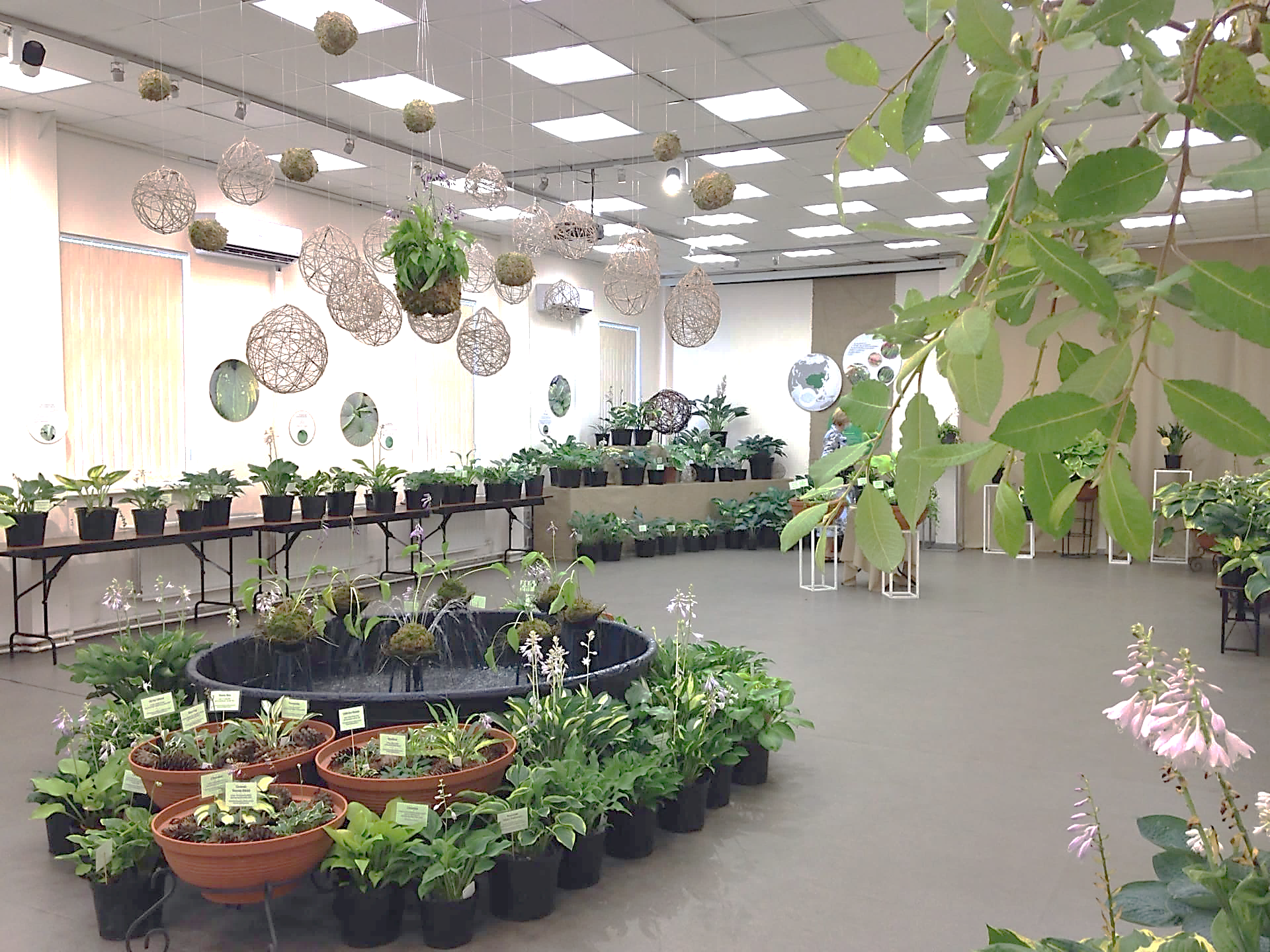
The open ground collections of the Botanical Garden of Peter the Great are represented by: tree nursery (more than 1000 taxa); herbaceous perennials (more than 1000 taxa); rock garden plants (more than 900 taxa); continuously flowering plants (more than 1100 taxa); bulbous and other monocot plants (more than 600 taxa); rose nursery (more than 300 taxa); food, fodder and medicinal plants (more than 650 taxa); flora of the Far East and East Asia (Japanese garden) (more than 200 taxa). Recently, the exposition of the Japanese Garden has become increasingly popular among visitors, where more than 100 excursions are held annually. Since 2019, specialized excursions have been organized at the rock garden collection, where visitors get acquainted with groups of plants from Siberia, the Himalayas, North America, the Caucasus, the Alps, as well as heather, foothill and steppe plants.
Landscaping, in particular, the cultivation of standard plants (Rosa L.,L.,L., etc.) in flower beds, can become an actual direction for familiarizing visitors with a wide range of plants. The practice of their use is depicted in photographs of historical flower gardens in the late 19th and early 20th centuries. In the photo of 1905,L. is used as perennials, and Vand. ex L. (Figure 03). The groups of bamboos exposed for the summer are also known to be used at the beginning of the 20th century. The analysis of the design of the central flower bed and parterres of the Imperial Botanical Garden of 1913 provides information on the use of adjoining crops:L. andVand . ex L., annuals:L.,L.,L.,L.,P. Browne, L’Hér., Roth, and carpet-cutting culture Forssk (Figure 04,). At present, due to high labor costs and long-term cultivation, this direction is rare, although, undoubtedly, it is one of the promising ones. For example, in the central flower bed of the Peter the Great Botanical Garden in 2020, in addition to plants of the Canna genera L., Antirrhinum L., Kochia Roth, Fuchsia L., Begonia L., Cineraria L., Coleus Lour standard culture Fuchsia L. is used (Figure 04,).
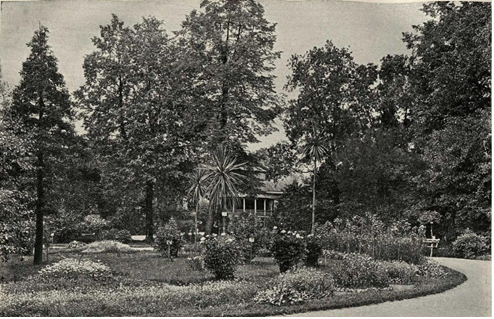
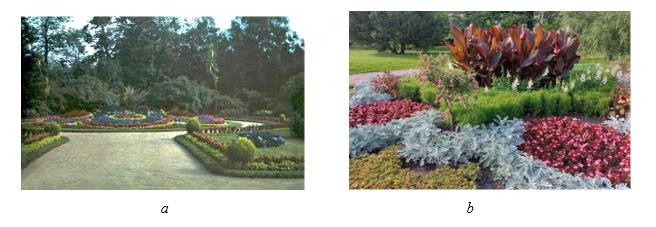
In the botanical garden, there is an opportunity to make a synthesis of perennial and annual crops in flower beds or create flower beds or specialized expositions of spicy aromatic plants or plants with a strong pleasant smell ofL.,L.,L.,L.,L.,L.,L. and others. This direction is widely used, including in the Garden for challenged people, where education is possible due to special beds and accompanying information in Braille (Figure 05,,).
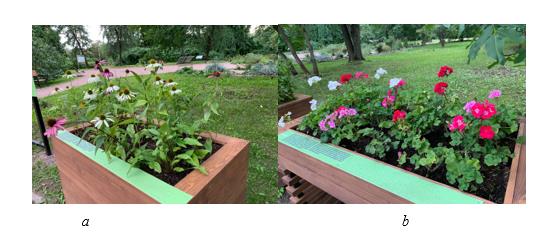
Considering the geographic location of the Botanical Garden of Peter the Great (North-West of Russia, the conditions of the 60th parallel of northern latitude), the use of tropical and subtropical perennial crops (Hydrangea Dumort.,L.,L.,L.,L., as well as representatives of the Bercht. & J. Presl, et al.) as a complement to flower arrangements seems to be unique and original direction. In the Botanical Garden there are still temporary remote compositions consisting ofL. _ ,Mill.,Mill. In 2009, during the renovation of greenhouses, one of the options for outdoor flower displays was a temporary exhibition of succulent plants. It was presented in the topics: 1. Plants that survived the blockade during the Second World War. 2. Historical plants from which the collection of the Garden began. 3. Succulent plants from different geographical areas. 4. Plants of different systematic groups on the example of plants of arid zones of the Earth.
In 2020–2021, in the course of research, the representatives of 20 genera belonging to 16 families were planted in the flowerbeds of the Botanical Garden. At the same time, plants of 48 genera belonging to 28 families were used in container culture. The expansion of the range of used plant species can be seen in the increase in the proportion of used perennial crops that are easily propagated vegetatively during the exposure season. It is necessary to note that now experts have the following requirements for planting material: bright color of flowers and leaves; ease of cultivation from seed to flowering; ease of vegetative propagation; good response to the increase in the agricultural background; quick set of habitus; resistance to the urban environment; uniformity in height and flowering time in one batch; unpretentiousness in transplantation (landing); anti-vandalism (rapid regrowth (recovery) in case of damage, breaking off); variability in the form of the plant itself.
In the Botanical Garden, the use of a variety of plants is a priority, in contrast to urban container gardening, where mass plantings of the same type of plants are used. In the Garden, when grouping, plants are selected that differ in size, color, leaf, inflorescence shape and habit. Such a selection allows drawing the attention of visitors to the Garden to each component of the presented compositions. An integral part is informational support and obligatory labeling, which reveals the essence of the ecology of the environment, contained in the taxonomic, phylogenetic and functional content of the presented plants. At the same time, the scientific function of landscaping is revealed, based on the current requests of the population to the establishment of science: the use of modern growing technologies, new varieties of plants, etc.
As in the city, so in the Botanical Garden there is container gardening. However, approaches to its design can have different goals. In an urban environment, containers are filled with either large dominant, more often the representatives of the genera of woody plantsL.,L.,L.,A. Dietr. or bright and profusely flowering herbaceous species of Juss.,L.,L'Her. For the city there is a need to organize bright color spots and spaces. The task is to emphasize architecture. Such design in the Garden serves not only as a decoration, but also as a way of cognition: the possibility of information support in the form of labels with extended information and stands describing flower groups and compositions.
A survey of visitors (506 respondents) reveals their requirements for the labeling of plants at the Garden's expositions. To the question "What information would you like to receive next to the plant?" respondents' answers were distributed in the following descending order: "place of origin" (85.6 %), "terms of flowering" (65.3 %), "Latin name" (53.3 %), "plant ecology" (46.0 %), "height" (31.6 %), “date of description” (13.6 %).
Observing the reaction of visitors of the Botanical Garden, their desire to see flowering plants was noted. Most likely, this is due to the need of people for bright colors, especially in the conditions of the cloudy weather prevailing in the climate of St. Petersburg. It is in the awakening and development of the aesthetic sense that the basis of the aesthetic function is laid.
However, the unusual appearance of some plants causes certain distorted opinions of visitors. For example, variegation is perceived as a disease, and curly appearance is often confused with a deformity associated with a fungal infection. The undoubted advantage of the botanical garden is the ability to inform visitors about various decorative forms and growth patterns. The sources of information can be Garden staff (gardeners and guides), etiquette (with explanations) and stands (with detailed information, anatomical sections, etc.). Thus, the educational function is realized.
Another example of the implementation of education is the BALKONIA project, which introduces visitors to the possibilities of decorating balconies. The visitors of the Botanical Garden have several reasons to use BALKONIA direction for their own design purposes. Firstly, BALKONIA implements a cognitive function, accumulating the experience in flower decoration in a particular area. Specialists take into account such characteristics of plants as fast growth, easy reproduction, bright color of flowers, affordability, etc. Secondly, having a large assortment of plants, the project provides visitors with completely new options for combining and selecting ornamental plants for decoration.
Balcony boxes on the street in the summer, decorated with indoor plants from the windowsill, can serve to improve the condition of the plants themselves, as well as the study of color and rules for composing floral compositions (Figure 06).
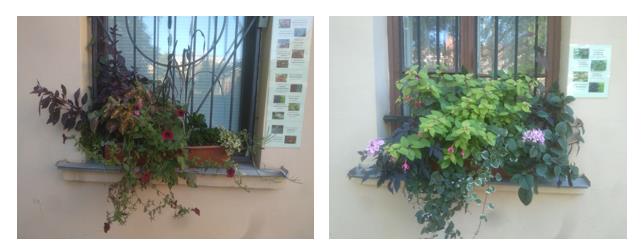
Conclusion
The analysis of individual collections of the Botanical Garden of Peter the Great demonstrates their functioning not only with the purpose of the development of botanical science, but also the educational potential contained in them. The development of collections is possible in the following directions:
- The isolation of thematic objects in the permanent exhibition.
- The synthesis of aesthetic, social, scientific and educational functions at temporary exhibitions.
- The expansion of the range of plant species used in flower gardening, as well as the use of standard and side crop practices in order to demonstrate the ecological properties of plants and their response to agricultural practices.
- Educational projects for a wide audience in order to get acquainted with the species used for urban greening in the area.
- The creation of an information field (etiquette, stands, posters, etc.) around plants for educational purposes at collections and exhibitions.
The permanent and temporary exhibitions and the effective methods used to display the collections are popular among the Garden visitors. The educational function is revealed in the presence of certain conditions: 1) the consideration of the historical component of the exposure of plants, 2) the openness for experiments in the form of the use of various methods of exposure, 3) the reliance on the scientific character of modern information support. The task of botanists-collectors is to develop the educational function of individual collections, relying on modern trends and the demands of society.
Acknowledgments
The work was carried out according to the state assignment N 122011900031-0.
References
Arnautova, E. M., & Romanova, E. L. (2016). Greenhouses of the Peter the Great Botanical Garden. First Publishing and Printing Holding.
Arnautova, E. M., & Yaroslavtseva, M. A. (2018). Thematic collections of the greenhouses of the Botanical Garden of Peter the Great BIN RAS and their role in educational activities. Hortus Botanicus, 1, 596–603.
Balasubramanian, A. (2021). Botanical gardens in India. University of Mysore. DOI:
Dodd, J., & Jones, C. (2010). Redefining the role of botanic gardens ‒ towards a new social purpose. Research centre for museums and galleries. http://www.bgci.org/files/Worldwide/Education/Social_inclusion/social%20inclusion%20report.pdf
Ischenko, A. V., Sovetova, M. P., & Mitina, E. G. (2020). Readiness of Russian Botanic Gardens potential visitors to participate in educational interaction. Science for Education Today, 10(5), 161–177.
Jackson, P. W. (2013). The developing role of botanic gardens in plant conservation: implementing the global strategy for plant conservation. In: Gardens in our hearts [Collective monograph based on the 3th conference “Life in harmony: botanical gardens and society – dialogue without boundaries] (pp. 35–51). Tver: Polipress Publishing House.
Kalugin, Y., & Musinova, L. M. (2020). Night of Museums in Peter the Great Botanical Garden. European Proceedings of Social and Behavioural Sciences, 2628–2638. DOI:
Kalugin, Yu. G. (2018). An integrated approach to the organization of cultural and educational activities in the collections of the open ground of the Peter the Great Botanical Garden of BIN RAS (through the example of the genus Syringa L.). Hortus Botanicus, 13, 655–658. DOI: 10.15393/j4.art.2018.5944
Kalugin, Yu. G., Musinova, L. P., & Volchanskaya, A. V. (2019). Open Ground Collections of Saint Petersburg Botanic Garden for the Benefit of Botanic and Environmental Education, AgroSMART – Smart solutions for agriculture. KnE Life Sciences, 956–967. DOI:
Mi-Ok, P., Ja-Ho, Ch., & Bon-Hak, K. (2020). Comparison of the Awareness of Garden Functions. Journal of the Korean Institute of Landscape Architecture, 48(2), 34–44. DOI:
Sokolov, S. Ya. (1957). The Botanical Garden and its introduction and cultural and educational work, From the Pharmaceutical Garden to the Botanical Institute. In: Essays on the history of the Botanical Institute. Academy of science SSSR. Publishing House of Academy of Science, SSSR.
Tkachenko, K. G. (2014). Rock garden of the Botanical Garden of Peter the Great. History of creation and principles of collection formation. Hortus Botanicus, 13, 6–21. http://hb.karelia.ru/journal/article.php?id=5744
Tkachenko, K. G. (2019) About the creation of specialized botanical gardens of medicinal plants of traditional Chinese medicine. Hortus Botanicus, 14, 156–161 http://hb.karelia.ru/journal/article.php?id=6084
Tkachenko, K. G., & SHi, L. (2018). Public and Botanical Gardens of China as centers for the preservation and study of cultural heritage, the priority of ecology in the service of improving human life. Hortus Botanicus, 13, 786–788. http://hb.karelia.ru/journal/article.php?id=5744
Yaroslavtseva, M. A. (2017). Educational and applied meaning of the collection of representatives of the family Commelinaceae. Materials of the International scientific conference dedicated to the 85th anniversary of the Central Botanical Garden of the National Academy of Sciences of Belarus (pp. 487–489). Medisont. https://elibrary.ru/item.asp?id=29659004
Zhirnov, A. D. (1977). The art of park building. Higher School.
Copyright information

This work is licensed under a Creative Commons Attribution-NonCommercial-NoDerivatives 4.0 International License.
About this article
Publication Date
23 December 2022
Article Doi
eBook ISBN
978-1-80296-128-7
Publisher
European Publisher
Volume
129
Print ISBN (optional)
-
Edition Number
1st Edition
Pages
1-1335
Subjects
Science, philosophy, academic community, scientific progress, education, methodology of science, academic communication
Cite this article as:
Kalugin, Y. G., & Musinova, L. P. (2022). Educational Function As A Basis For The Development Of Scientific Botanical Collections. In D. K. Bataev, S. A. Gapurov, A. D. Osmaev, V. K. Akaev, L. M. Idigova, M. R. Ovhadov, A. R. Salgiriev, & M. M. Betilmerzaeva (Eds.), Knowledge, Man and Civilization- ISCKMC 2022, vol 129. European Proceedings of Social and Behavioural Sciences (pp. 583-593). European Publisher. https://doi.org/10.15405/epsbs.2022.12.75

